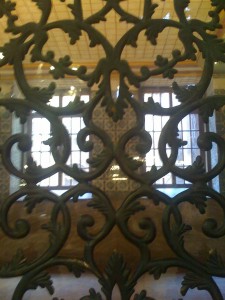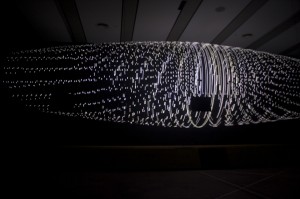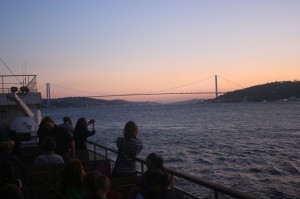Electronic art, like Istanbul, is misunderstood and often stereotyped by people who make assumptions without experiencing the richness of its many forms. And, like Istanbul, electronic art is a vast amalgamation of forms informed by many cultures and histories.

Fretwork: Hagia Sophia. Image: Vicki Sowry
Attending ISEA2011 was an opportunity to connect to and be part of the international electronic arts community, and plan for our shared future. It also gave me an opportunity to connect with my ‘motherland’. I am an Australian-born woman of Turkish parents and I see myself as primarily Australian, but when I return to Turkey I feel healed from the disconnection I feel living such a distance from my cultural heritage.
Compared to other festivals, ISEA2011 seemed quite dry at times, with an emphasis on academia and institutions, rather than individual artists. I would have liked to have seen a festival that promoted exhibitions that encouraged Istanbul’s general public to attend. My favourite parts of ISEA2011 were the exhibitions, networking events and special events.
The ‘matter-light 2′ show at Borusan Music House, curated by Richard Castelli was amazing. I am somewhat jaded by art, but I loved how this show touched my heart, soul, curiosity and sense of nostalgia – with the artists using various technological and analog lo-tech works in innovative ways. I returned to see Chistian Partos’ work VISP three times; I was mesmerised by its meditative, hypnotic ways. VISP created animated patterns using LEDs that switched on and off, on a revolving 10 metre light wire, making captivating 3D forms with such simplicity. Some glittered in the dark like magic dust, and the woo-woo sounds of the vibrating rotating wire added an edge of danger and mystery. It was pure magic. A lot of electronic art can be cerebral and conceptual, so it was exciting to see ‘touching’ pieces of art that were not highbrow or requiring a knowledge of art text and history to truly appreciate.
The”uncontainable” show, which included Australia’s contribution to the exhibition program, was well curated, although not many of the works reached me deeply emotionally. This is, for me, an issue with electronic arts – the works were technically and conceptually sound and effective, but do not engage me on an emotional level. One exception was the work Akousmaflore by scenocosme : Gregory Lasserre & Anais met den Ancxt, as part of “uncontainable and untitled” was a work with plants – a breathing wall-piece. I also loved some pretty silly things at ISEA2011 – at the YEM Building show there was a Pong game you could play using your body as the Pong paddle – simple and childlike, yet fun! I also enjoyed the Kurye Space Invaders video at the same show – a space invaders game which combined VJing, live performance and music in a spectacualr 3D experience utilising projections on objects.

Christian Partos' VISP . Image: Yasemin Sabuncu
One of my favourite talks was “A Cyber Semiotic Approach to Technoetic Arts“, a paper given by Kathrine Anker, a PhD Candidate from Plymoth University, UK. This paper discussed creating new vocabularies in transdisciplinary research and discussed the notion of human beings as ‘organic text’ and raised questions of what sentience, consciousness and being human is all about. This area of academia raises the question “Why do we need to create another sentience when we do not fully explore our own – or can often act like robots?”
This topic was raised a few times during ISEA2013 – the panel discussion on Hybrid Cultures also questions the difference between humans and machines, real and virtual, human and robot.

Ferry ride along the Bosphoros. Image: Yasemin Sabuncu
I didn’t really get a sense of the number of attendees and speakers at ISEA2011 until I attended a networking event on a ferry that travelled along the Bosphoros, bridging Asia and Europe. A ferry ride was a welcome escape from the Sabanci University basement, where most of the ISEA2011 events were held – and a fantastic opportunity to connect with peers, friends and mentors from around the world. It was also an opportunity to see Istanbul’s bridges illuminated with lights programmed to form simple yet distinct animations.
ISEA2011 presented a combination of the future of electronic art and a return to nostalgic simplicity – a combination that was not only a theme in ISEA2011, but also currently in the world at large. As art reflects societal change, I think this shows that humanity is seeking simplicity within all the multiplicity, busy-ness and mass communication now in our world. ISEA2011 provided avenues for the electronic arts community to get together and work on its future direction, forge more acceptance of the artform and examine sustainability of practice – while looking at its past with fondness and nostalgia.
Yasemin Sabuncu
Yasemin Sabuncu is a visual artist who also works in design, digital media production, performance, directing and social media strategy. Her works have been featured across international galleries, festivals, publications and events. Her short film Esmerelda won the Melbourne Underground Film Festival experimental short film category in 2005, and was showcased in the Australian best video art from 1999-2004 as part of Dlux Media’s D’Art Festival. Currently she is in early stages of developing and gathering funding for a cross platform comedy show set in Byron Bay which embraces the use of Social Media, Technology and audience participation.
ISEA2011 Istanbul: The 17th International Symposium on Electronic Art was held 14 – 21 September 2011 in Istanbul, Turkey.
http://isea2011.sabanciuniv.edu






